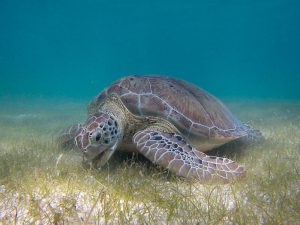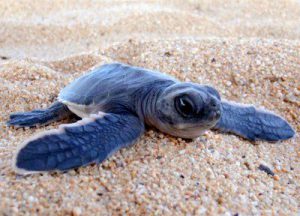Sea turtles first appear in our fossil record approximately 200 million years ago during the Jurassic, however they are believed to have diverged from mainstream reptiles much earlier. Today, seven species of sea turtles exist… we think. When it comes to our own resident green turtles, the jury is still out.
Green turtles are distinguished by their large bodies (up to 700lbs!) and relatively small heads. Their skull morphology is dwarfed from a dietary shift towards nutrient poor sea grasses during adulthood.
 (P. Lindgren)
(P. Lindgren)
This shift also gives them green fat, the origin for their name. Unlike many other turtles, green turtles will actually swim ashore outside of their breeding season to warm themselves.
Despite these characteristics and behaviors, what truly distinguishes green sea turtles? One of the challenges faced by modern scientists, with all the technology we have to make decisions, is deciding what truly constitutes a species. In the case of the Green Sea Turtle, there would appear to be two distinct populations that possibly do not interbreed. This observation is based primarily on location and body color: Eastern pacific (western north america) green sea turtles actually appear black, while southern pacific an asiatic green sea turtles exhibit an expected olive to brown coloration. The latter may also migrate around the southern tip of Africa to the Atlantic ocean. Despite these trends in isolation, both have occasionally been found in each others “territories” just to keep scientist guessing!
 Regardless of home ranges, Green sea turtles encounter numerous hurdles in their lifetime. They are born in the sand where hatchlings shed their leathery eggshells and squirm relentlessly in concert with their legion of siblings. This action actually sifts the sand below them, which is why their eggshells can be found on the beaches of their nests. Surely they would not expend the extra energy as newborns to dig up their cases only to abandon them! Upon surfacing, juveniles scramble to the sea, orienting to the horizon and surf along the way. Those that survive the surf and heavy predation of coastal waters will go on to live long lives, traveling hundreds of thousands of miles in a lifelong search for food throughout the largest habitat on earth: the open ocean. Natal homing ensures that females will eventually return to nesting sites at or near their birthplace. Pregnant, and weighing hundreds of pounds more since their last landfall, the mothers dredge themselves through sand and pebbles to deposit their precious clutch, before slipping silently into the sea. This may occur many times throughout the breeding season. Here the eggs will incubate. In time, the next generation will emerge. (National Geographic)
Regardless of home ranges, Green sea turtles encounter numerous hurdles in their lifetime. They are born in the sand where hatchlings shed their leathery eggshells and squirm relentlessly in concert with their legion of siblings. This action actually sifts the sand below them, which is why their eggshells can be found on the beaches of their nests. Surely they would not expend the extra energy as newborns to dig up their cases only to abandon them! Upon surfacing, juveniles scramble to the sea, orienting to the horizon and surf along the way. Those that survive the surf and heavy predation of coastal waters will go on to live long lives, traveling hundreds of thousands of miles in a lifelong search for food throughout the largest habitat on earth: the open ocean. Natal homing ensures that females will eventually return to nesting sites at or near their birthplace. Pregnant, and weighing hundreds of pounds more since their last landfall, the mothers dredge themselves through sand and pebbles to deposit their precious clutch, before slipping silently into the sea. This may occur many times throughout the breeding season. Here the eggs will incubate. In time, the next generation will emerge. (National Geographic)

Although there range extends to southern Alaskan waters, increasingly warm surface temperatures have meant increased sightings on Catalina. Encounters near Guano Rock are always a welcomed but passing pleasure. Fleeting appearances of this mysterious creature are inspiring, and whether they are at home, or just visiting, green sea turtles will always have a special place here on Santa Catalina Island.
(KnowledgeBase)


